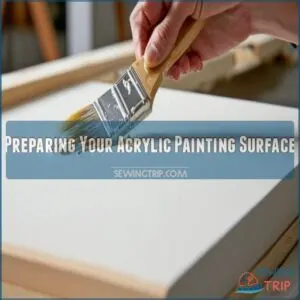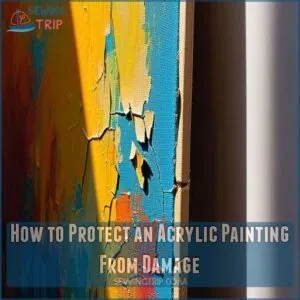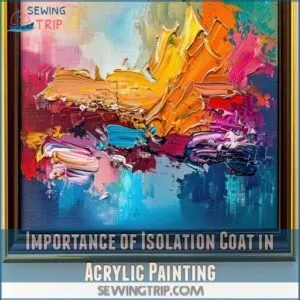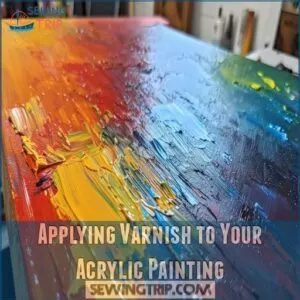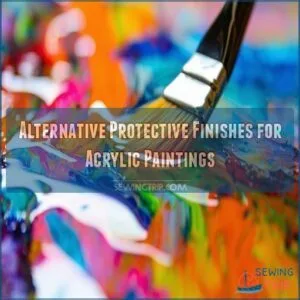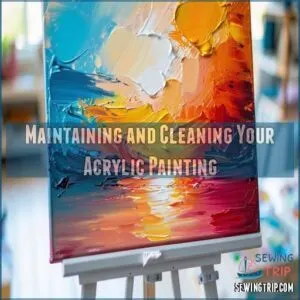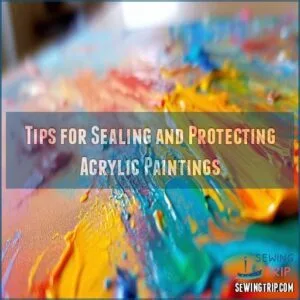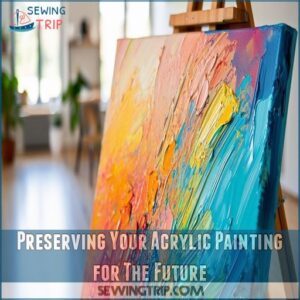This site is supported by our readers. We may earn a commission, at no cost to you, if you purchase through links.
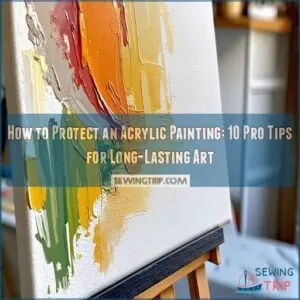 To protect an acrylic painting, start with a primed canvas, ensuring better adhesion and a smooth finish.
To protect an acrylic painting, start with a primed canvas, ensuring better adhesion and a smooth finish.
Apply an isolation coat to shield the paint.
Varnishing is essential, as it guards against dust, dirt, UV rays, and moisture—think of it as sunscreen for your masterpiece.
Choose the right varnish type, water-based for smaller works and solvent-based for larger ones.
Regular maintenance, like dusting with feather dusters and keeping away from direct sunlight, extends its life.
Avoid DIY mistakes like using hairspray, and stay tuned to discover more about safeguarding your painting while keeping it vibrant forever!
Table Of Contents
- Key Takeaways
- Preparing Your Acrylic Painting Surface
- How to Protect an Acrylic Painting From Damage
- Importance of Isolation Coat in Acrylic Painting
- Choosing The Right Varnish for Your Acrylic Painting
- Applying Varnish to Your Acrylic Painting
- Alternative Protective Finishes for Acrylic Paintings
- Maintaining and Cleaning Your Acrylic Painting
- Displaying and Storing Your Acrylic Painting
- Tips for Sealing and Protecting Acrylic Paintings
- Preserving Your Acrylic Painting for The Future
- Frequently Asked Questions (FAQs)
- Conclusion
Key Takeaways
- Prime your canvas with gesso for a smooth surface and better paint adhesion.
- Apply an isolation coat before varnishing to protect your artwork and make varnish removal easier.
- Choose the right varnish (water-based for smaller pieces, solvent-based for larger ones) and apply it evenly in thin coats.
- Protect your painting from direct sunlight, dust, and moisture to maintain its vibrancy and longevity.
Preparing Your Acrylic Painting Surface
To make sure your acrylic painting stays vibrant and intact, start by preparing the canvas with a reliable primer.
Applying gesso in one to three layers will create a smooth, adhesive surface, preventing cracks and enhancing your artwork’s longevity.
Priming Canvas for Better Adhesion
Wondering how to get paint to stick well?
It all starts with priming your canvas, a process also known as Prepping Your Canvas Fabric.
Use the right primer to enhance adhesion and create a strong base.
Apply a couple of primer layers before painting.
Don’t rush—let each layer dry.
This step makes your artwork durable, making it resistant to peeling or cracking over time!
Using Gesso for a Smooth Finish
For a smooth acrylic painting surface, gesso is your best friend.
First, pick from different gesso types—store-bought or homemade.
Apply in even layers: one for coverage, three for silky smoothness.
You can find a variety of gesso products specifically designed for acrylics at gesso for acrylic.
The benefits of smoothness? Even brush strokes, improved paint adherence, and a professional finish.
If you’re skipping gesso, remember your canvas mightn’t be as forgiving.
How to Protect an Acrylic Painting From Damage
Moving from priming to safeguarding, let’s explore how to protect your acrylic painting from damage. You’ve put in the hard work, now make sure it lasts. Here’s how:
- Varnishing for Defense: Applying a varnish acts like a shield, fending off dust and grime. A removable varnish is your go-to for flexibility and future touch-ups.
- UV Shielding: Display wise, keep paintings away from direct sunlight. Think of UV protection like sunscreen for your artwork, keeping colors vibrant.
- Sweat the Small Stuff: Cleaning techniques matter. Use a feather duster or soft brush to gently remove dust. Avoid wet methods; moisture is acrylic’s kryptonite.
Armed with these tips, you’re ready to preserve your masterpiece for years of admiration.
Importance of Isolation Coat in Acrylic Painting
Many artists overlook an important step: the isolation coat. Think of it as your painting’s superhero undercoat! It sits between your artwork and the final varnish, acting as a protective barrier. This simple addition dramatically improves your painting’s longevity.
Why bother? Well, an isolation coat makes varnish removal a breeze, preventing damage to your precious paintwork. It also prevents yellowing and keeps dust from settling directly onto your masterpiece. This guarantees your artwork stays vibrant and beautiful for years to come. Here’s a quick look at the benefits:
| Benefit | Description |
|---|---|
| Easier Varnish Removal | Simplifies future cleaning and restoration. |
| Yellowing Prevention | Keeps your colors bright and true. |
| Dust Control | Protects your art from environmental grime. |
| Enhanced Paint Longevity | Extends the lifespan of your artwork. |
| Achieves Archival Quality | Helps maintain the highest standards of preservation. |
Applying an isolation coat is easy. A simple mixture of Golden Soft Gel Gloss and water works wonders. By applying a protective sealant, like those used to shield Angelus spray paint, your artwork can be safeguarded against environmental damage. This extra layer guarantees your acrylic painting stands the test of time, looking its best for years to come.
Choosing The Right Varnish for Your Acrylic Painting
Choosing the right varnish for your acrylic painting isn’t just about picking the first bottle you see.
You need to think about whether you’re working on smaller pieces that suit water-based varnishes or larger canvases that benefit from the durability of solvent-based options like Golden Polymer Removable Varnish.
Water-Based Varnishes for Smaller Paintings
Choosing the right varnish seals the deal—literally.
Water-based varnishes are perfect for smaller acrylic paintings, making them feel like the pampered kids they are.
Quick to dry and easy on the wallet, these varnishes offer a smooth finish with options for matte, satin, or glossy sheens.
Just remember, patience is key when applying to avoid streaks.
Solvent-Based Varnishes for Larger Paintings
If you’re tackling a large acrylic piece, MSA varnish is your go-to.
These solvent-based varnishes are tough cookies; they offer flexibility and a longer drying time.
- Effective surface prep is key
- Use a well-ventilated space
- Choose a satin or gloss sheen
- Perfect your application techniques
- Don’t rush the drying phase
Your masterpiece deserves it!
Golden Polymer Removable Varnish
Golden Polymer Varnish is a top pick for acrylic painting due to its ease of removal and clear finish. When working with acrylics, it’s essential to consider the potential for paint stains, such as when painting on denim fabric, and take necessary precautions to protect your art.
When applying, follow these tips for a flawless result:
| Step | Details | Tips |
|---|---|---|
| 1 | Use a soft brush | Apply in even strokes to avoid streaks |
| 2 | Let it dry thoroughly | Patience helps it last longer |
| 3 | Choose sheen wisely | Matte, satin, or gloss affects outcome |
This varnish keeps your art vibrant and protected.
Applying Varnish to Your Acrylic Painting
Applying varnish to your acrylic painting is like adding a superhero cape—it provides protection and enhances colors.
Varnish will protect your painting and enhance its colors.
You’ll need a steady hand and patience, whether you’re using a brush, spray, or sponge to evenly coat your masterpiece.
Brush Application for Smaller Paintings
Applying varnish with a brush on smaller paintings gives you control over every stroke, ensuring a smooth finish.
Start with consistent paint density and apply thin layers to avoid running.
Remember, drying time is important; allow each coat to dry before adding another.
Cleanup isn’t complicated—just rinse brushes promptly in water and mild soap, keeping tools pristine for next time.
Spray Application for Large-Scale Paintings
For large canvases, a spray application offers an even varnish coat.
Choose from various spray gun types, ensuring proper ventilation for safety precautions.
Even application is key; several thin coats are better than one thick one.
Consider varnish selection carefully; drying time varies.
Remember, practice makes perfect!
Sponge Application for Water-Based Varnishes
Tackling large canvases with a spray can be exhilarating, but sometimes a sponge is your best friend for water-based varnishes.
When you’re all set, aim for an even coating technique: lightly dab to avoid bubbles, ensuring a smooth finish.
To achieve a professional-looking result, consider using a permanent non-removable satin gloss finish, as it’s recommended by 97% of professional artists.
Remember, bubbles are to varnish what mosquitoes are to summer—unwanted!
These sponge application tips will keep your artwork stunning and safe.
Alternative Protective Finishes for Acrylic Paintings
You don’t have to stick with traditional varnishes to protect your acrylic paintings; alternative finishes like epoxy provide a glossy, durable barrier, while MinWax can offer a cost-effective solution.
Each option has its quirks and benefits, but they all aim to safeguard your art from dust, moisture, and time’s relentless march.
Epoxy as a Durable and Water-Resistant Finish
Looking to step up from varnish with something a bit more robust? Epoxy might be your ticket.
It’s like giving your painting a glass shield, perfect for outdoor art. To find the right one for your needs, you can check out some of the best epoxy for paintings here for art supplies.
Pros and Cons:
- Provides a sleek, glossy finish
- Water-resistant magic
- Tackling application takes patience
- Contact with fumes? Not your everyday picnic
- Expense is on the higher side
MinWax Protective Finish for Acrylic Paintings
If you’re exploring durable finishes, MinWax offers a tough alternative to traditional varnish.
It’s like a suit of armor for your art, protecting against wear.
For those interested in more unconventional surfaces, fabric paint on plastics can also be sealed with a clear acrylic sealer or matte varnish for added protection.
Here’s a snapshot:
| Feature | MinWax | Traditional Varnish |
|---|---|---|
| Durability | Excellent | Good |
| Application | Brush/Spray | Brush/Spray |
| Cost | Moderate | Low to Moderate |
MinWax brings longevity and a subtle shine to your cherished pieces.
Maintaining and Cleaning Your Acrylic Painting
Keeping your acrylic painting looking fresh can be as simple as dusting it with a feather duster and avoiding using wet cloths.
Just remember, if the paint ever starts looking like it’s from an ancient museum, it’s time to call in the pros for a clean-up.
Using a Feather Duster for Dust Removal
Keeping your acrylic masterpiece spotless is easier than you think when you grab a feather duster, and remember to regularly inspect your paint’s consistency and address any issues with rubbery acrylic paint by learning how to fix rubbery acrylic paint.
Gently wave it over your artwork, and you’ll effortlessly whisk away dust without scratching the surface.
Remember, a light touch is all you need. It’s like giving your painting a gentle hug, preserving its beauty for years to come. Your artwork will thank you!
Avoiding Wet Cloths and Skin Contact
After dusting, resist the urge to use wet cloths.
Water’s a painting’s worst enemy, leading to surface damage.
Think of it like this: you wouldn’t wash your favorite sweater in a washing machine, right?
Likewise, avoid touching the artwork with bare hands.
Oil transfer from your skin can dull the colors and cause long-term issues, so keep your hands clean.
Gentle care is key to preserving your art.
Professional Art Cleaning for Heavily Soiled Paintings
When dusting off with feather dusters doesn’t cut it, professional art cleaning steps in.
Experts assess damage and apply ethical cleaning techniques to revitalize your artwork safely.
In some cases, they may also use specialized acrylic painting cleaners.
Though it might cost more, entrusting your painting to skilled restorers guarantees minimal damage and long-lasting preservation.
Think of it as sending your art to a day spa—refreshing and necessary!
Displaying and Storing Your Acrylic Painting
When displaying your acrylic painting, keep it away from direct sunlight to prevent fading and use UV-protected glass or plastic for framing.
For storage, maintain a humidity level of 55% to protect against warping and cracking.
Minimizing Sun Exposure to Prevent Fading
Sunshine can be an art thief, robbing your painting of its vibrancy. To guard against UV light damage and preserve color:
- Hang paintings away from direct sunlight to minimize fading.
- Use UV-filtering window films for extra protection.
- Rotate artworks periodically to equalize exposure.
- Install curtains or blinds to control light intensity.
- Choose display spots with soft lighting.
Using UV-Protected Plastic or Glass for Framing
Putting an acrylic painting behind UV-protected plastic or glass is like giving it sunglasses—shielding it from harmful rays.
Choosing between plastic and glass depends on your budget and needs.
Here’s a quick look:
| Factor | UV-Protected Plastic | UV-Protected Glass |
|---|---|---|
| Weight | Lighter | Heavier |
| Cost | More affordable | More expensive |
| Durability | Less prone to breakage | Fragile |
| Clarity | Good | Excellent |
| Maintenance | Easy to clean | Needs careful handling |
Both options have their pros and cons, so weigh them carefully for DIY or custom framing projects.
Maintaining a Humidity Level of 55%
Humidity’s the sneaky culprit behind your painting’s doom if ignored.
Keeping levels at 55% helps dodge damage from warping and cracking.
It’s like giving your artwork a comfy climate-controlled home.
Pop a hygrometer in your space for real-time monitoring.
Adjust with a humidifier or dehumidifier—control that environment and keep your masterpiece safe from nature’s quirks.
Tips for Sealing and Protecting Acrylic Paintings
Sealing your acrylic paintings is done by using techniques like heat setting or applying varnish in thin layers, which can be specifically applied on fabric by following a guide on how to seal acrylic paint on fabric. Sealing your acrylic paintings is like giving them a superhero cape to fend off dust and UV rays.
Not all sealants are created equal.
Make sure you choose the right varnish and steer clear of hairspray, saving your artwork from a sticky situation.
Using Removable Varnish for Future Preservation
Proper storage protects your artwork, but what about future cleaning?
Removable varnish is your secret weapon. It’s like insurance for your masterpiece!
- Choose a high-quality, removable varnish.
- Apply it evenly, following the manufacturer’s instructions.
- Varnish removal techniques are easier with a removable option.
- This protects your painting, and makes future cleaning a breeze.
Avoiding Hairspray as a Sealant
Using removable varnish keeps your painting safe, but don’t be tempted by hairspray as a sealant. It’s like using a cardboard umbrella in a downpour—patchy and unreliable. Hairspray introduces risks of yellowing and cracking your masterpiece.
Stick with products designed for art preservation to make sure your acrylic remains protected and vibrant, avoiding paint damage.
| Hairspray Use | Varnish Use |
|---|---|
| Short-term fix | Long-term safeguard |
| Unpredictable results | Consistent protection |
| May harm paint | Enhances colors |
| Ineffective seal | Reliable barrier |
Choosing The Right Sealant for Your Painting
Choosing the right sealant is like finding the perfect jacket for your painting—it adds a layer of protection while maintaining its charm.
Varnish types include matte, satin, and gloss, each offering different levels of sheen to match your artwork’s personality.
Consider surface texture and the purpose of sealing when deciding between acrylic-specific or traditional oil varnishes.
Preserving Your Acrylic Painting for The Future
To make sure your acrylic painting lasts for decades, it’s critical to use proper preservation techniques.
By understanding the importance of protection, you’ll keep your art safe from dust, fading, and accidental damage.
Why Protecting Acrylic Paintings is Important
You’ve done a great job sealing and protecting your acrylic painting, but don’t stop there.
Protecting your art is like putting on a raincoat before heading out—it’s smart and keeps you covered.
Preserving value means preventing fading and maintaining vibrancy.
You’re extending the lifespan of your piece, resisting damage, and enjoying your masterpiece for years to come!
Frequently Asked Questions (FAQs)
How to protect acrylic painting on canvas?
Seal your masterpiece! An isolation coat protects your acrylics. Then, varnish it—matte, satin, or gloss—for a durable, dust-resistant shield. Easy peasy, lemon squeezy!
How do you protect acrylic paint from cracks?
Prime your canvas with gesso for smoothness and improved paint adhesion.
Apply an isolation coat before varnishing to protect against surface damage.
Regularly dust the painting and avoid excessive sunlight to prevent cracking.
What happens if you don’t protect acrylic paintings?
Studies show that unprotected acrylic paintings can deteriorate three times faster.
Without protection, they risk damage from dust, UV rays, and humidity.
This neglect can lead to fading, yellowing, or even mold growth over time.
Why do you need to protect acrylic paint?
Protecting acrylic paint keeps it vibrant and durable.
Over time, without protection, dust, dirt, and UV light can cause fading and damage.
A protective layer like varnish shields your art, preserving its beauty and longevity.
Do you need to seal an acrylic painting?
You should seal an acrylic painting to shield it from dust, dirt, and UV rays.
Sealing deepens colors and evens out the sheen, giving your artwork a professional finish that’ll stand the test of time.
What can you put over acrylic paint to protect it?
To shield your acrylic masterpiece from the ravages of time, slap on a hearty layer of varnish.
Choose a gloss, satin, or matte finish to enhance and protect, creating a barrier against dust, dirt, and UV rays.
How to protect a canvas acrylic painting?
Prime your canvas with gesso, apply an isolation coat, and finish with a varnish.
This trio safeguards your art from dust and sunlight while enhancing color and finish.
Frame it to prevent accidental scratches or dings.
How to preserve acrylic paint?
Think of your acrylics as delicate flowers; they need care!
Store them in a cool, dark place, tightly sealed.
Avoid extreme temperatures.
Clean your brushes thoroughly after each use.
That’s it!
How to repair a scratched acrylic painting?
Gently buff the scratch with a soft microfiber cloth.
If the scratch persists, apply a thin isolation coat using Golden Soft Gel Gloss and water.
Let it dry, then reapply varnish to blend and protect.
Can acrylic paintings be laminated for protection?
Over 50% of artists explore unconventional methods for acrylic protection.
Laminating can be an option, but it might cause damage over time due to temperature changes and adhesive issues.
It’s better to use varnish for easier maintenance.
What materials should I avoid near acrylic paintings?
Keep acrylic paintings away from moisture, direct sunlight, and harsh chemicals.
Avoid aerosols, oils, and sharp objects nearby.
These can cause fading, damage, or scratches.
Store them at stable temperatures to maintain their vibrant appeal and longevity.
How do temperature changes affect acrylic paintings?
Imagine acrylic paint as a sturdy shield, yet it’s vulnerable to wild temperature swings.
Sudden changes can cause cracking or warping.
Keep painting in a stable climate to maintain pigment adhesion and prevent damage, keeping your artwork pristine.
Is it safe to transport acrylic paintings regularly?
Transporting acrylic paintings regularly is safe if you pack them well, using bubble wrap and cardboard corners to protect edges.
Avoid extreme temperature changes and keep them upright to prevent damage during transit.
Conclusion
Just like a fence protects a garden from pests, safeguarding your acrylic painting guarantees its vibrancy and longevity.
By prepping your canvas, applying an isolation coat, and choosing the right varnish, you prevent damage from dust, UV rays, and moisture.
Regular maintenance keeps your artwork pristine, while proper display and storage avert potential hazards.
With these techniques, how to protect an acrylic painting becomes straightforward, giving your cherished creation the care it deserves for years to come.

